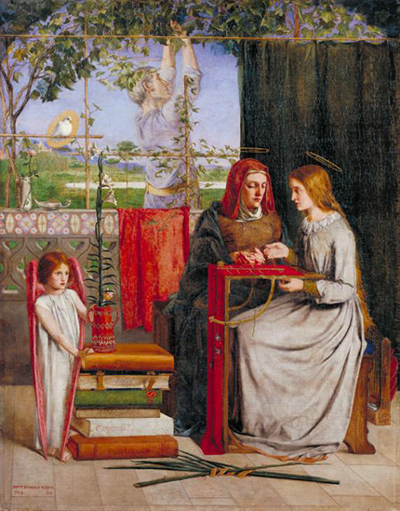The painting of The Girlhood of Mary Virgin depicts the Virgin Mary as a young girl with her mother; they are working on an embroidery whilst her father, Joachim, is trimming a vine outside.
The image is detailed with a number of symbols such as the dove in the background which portrays peace and the Holy Spirit, the lilies which represent the Virgin’s purity, the palm branch on the ground which symbolises Christ’s Passion, and also the stack of books which suggest the virtues of faith, charity and hope. Attached to the painting was a gold sheet of paper with two sonnets written on it, describing the symbolism used within the picture and its worth in reference to Catholicism. Although these sonnets describe some of the painting’s Christian symbology, there is still much that is left for the viewer to find.
For example, the trellis that Joachim is working on actually places a cross at the centre of the image and the red cloth draped also at the heart of the work is reminiscent of the robe of Christ’s Passion. This is incidentally the very same that Mary and her mother are embroidering. The colours within the painting are conscientiously selected and are also symbolic; the cloth being blood red, for example, and a depiction of that worn by Christ, as well as the stack of books where the colours are indicative of the qualities in which they represent (hope, faith and charity, respectively).
The Girlhood of Mary Virgin was the first major oil painting of Dante Gabriel Rossetti’s and he inscribed ‘PRB’ onto it; the initials of the emerging movement, the Pre-Raphaelite Brotherhood. However, unlike the hyper-realistic artwork many of the Pre-Raphaelite Brotherhood created, this particular painting was incredibly literal in its portrayal. In contrast to, say, Hunt or Millais' work, The Girlhood of Mary Virgin is far less meticulous in its details and presents something more romantic and perhaps even Faustian; the stack of books, for example, may be evocative of a thirst for the spirit and knowledge of the divine power of God. The artwork currently resides at the Tate Britain in London.




